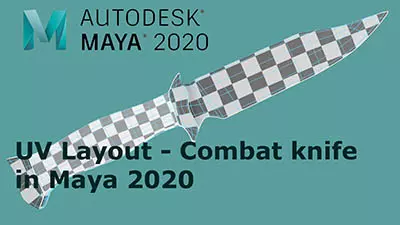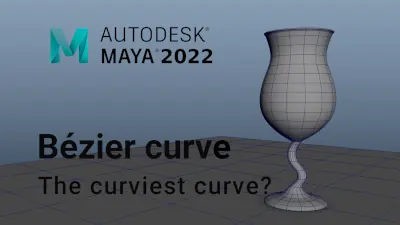Introduction to Maya - Modeling Fundamentals Vol 1
This course will look at the fundamentals of modeling in Maya with an emphasis on creating good topology. We'll look at what makes a good model in Maya and why objects are modeled in the way they are.
#
1
08-02-2013
, 03:02 PM
Registered User
Join Date: Dec 2012
Join Date: Dec 2012
Posts: 34
Weird Object
I have a *.stp file which I opened up in Maya. (picture 1)
I now would like to modify and edit this model, move vertexpoints, faces etc..
What am I supposed to do that I can work with this thing?
When I convert NURBS -> POLYGONS it gets even worse (picture 2)
I would greatly appreciate your help.
Thanks so much!
PhilCC
#
2
08-02-2013
, 07:07 PM
The first problem you are seeing is that when you are converting all the trimmed surfaces are re-appearing. You can select the right options in the convert tool to prevent this but you'll have to delete all the history on the object, separate it, and work on converting each piece individually.
Then the next problem you will have is all the poly tessellation will be horrible and you'll have to fiddle more with the conversion tool options for each part.
Then you'll realize you have seams all over the mesh because none of the parts edge verts will be likely to match.
and finally after lots of wasted time you'll realize converting complex trimmed nurbs parts directly to polygon meshes is pretty much a complete wast of time.
I have had some success taking the nurbs model and making it live and then manually rebuilding a clean poly mesh on top.
You can also use tools like topogun and 3d-coat, to model over the top of the nurbs form a little more efficiently then in maya. But I still have not come up with an efficient workflow to do this in any package yet.
"If I have seen further it is by standing on the shoulders of giants." Sir Isaac Newton, 1675
Last edited by ctbram; 09-02-2013 at 07:33 PM.
#
3
08-02-2013
, 07:17 PM
#
4
08-02-2013
, 07:25 PM
I came from a NURB's background and have gone through this process of trying to take nurbs models and message them into polygons. What I went through above is kind of the stages you go through before you realize "I can't get there from here, damn!".
"If I have seen further it is by standing on the shoulders of giants." Sir Isaac Newton, 1675
#
5
08-02-2013
, 07:48 PM
EduSciVis-er
Join Date: Dec 2005
Join Date: Dec 2005
Location: Toronto
Posts: 3,374
#
6
08-02-2013
, 08:28 PM
Yeah, Rick was saying that.Is there an option to make a surface live and build the polys on top of the surface?
#
7
08-02-2013
, 08:32 PM
EduSciVis-er
Join Date: Dec 2005
Join Date: Dec 2005
Location: Toronto
Posts: 3,374
#
8
09-02-2013
, 04:46 PM
Registered User
Join Date: Dec 2012
Join Date: Dec 2012
Posts: 34
So I will give it a try and rebuild it over this mesh with polygons.
Would you propose to do it in a way similar to having blueprints and then just model?
I did not do that original mesh, can you tell me how it was done and why it was done so messy without any options to edit it afterwards?
#
9
09-02-2013
, 07:53 PM
It can be a tedious process and there is a bit of planning involved to work out the the correct number of polys in the rings and strips so they match up.
Here is something that may help...
Take the object you want to make live and apply a blinn material to it and make it slightly transparent and finally make it live. This will help you see the polys as you as you create them on top of the live surface.
What I usually do is create a starting polygon and then extrude an edge off that polygon. You have to remember to then move each vertex as the newly created edge will have its center point snapped to the live surface and not the two end verts.
So you extrude an edge then jiggle the verts to snap them and repeat this over and over. As I said it's a tedious process.
"If I have seen further it is by standing on the shoulders of giants." Sir Isaac Newton, 1675
Last edited by ctbram; 09-02-2013 at 07:57 PM.
#
10
09-02-2013
, 10:57 PM
Registered User
Join Date: Dec 2012
Join Date: Dec 2012
Posts: 34
Seems like a similar process to rebuilding a face with polygonplanes right?
I have to build it very 100% precisely and form-true. I have exact guidelines on the dimensions.
What is the Best way to get perfect round holes because if i build planes around it will get a bit buckled.
And is there a good way I can build the object (especially the holes) to afterwards be able to transform it. Let's say I would need one radius of the hole to be bigger or smaller and i would like to move the holes. Is there a way to do so without destroying the whole mesh?
Already thank you again! That helped a lot.
#
11
09-02-2013
, 11:31 PM
"If I have seen further it is by standing on the shoulders of giants." Sir Isaac Newton, 1675
Posting Rules Forum Rules
Similar Threads
trouble opening maya scene
by jooleyinboots in forum Maya Technical Issues replies 3 on 07-10-2022
Convert Camera Translation to Object rotation?
by jimvfx in forum Animation replies 0 on 28-01-2015
Normal Map definitions
by djwaterman in forum Lighting & Rendering replies 2 on 25-05-2012
maya 2008 very weird problem. faces are missing on object
by dubai3d in forum Maya Basics & Newbie Lounge replies 15 on 04-04-2012
weird deformation when moving an object
by INOX in forum Maya Basics & Newbie Lounge replies 2 on 29-02-2008
Topics
Free Courses
Full Courses
VFX News
How computer animation was used 30 years ago to make a Roger Rabbit short
On 2022-07-18 14:30:13
Sneak peek at Houdini 19.5
On 2022-07-18 14:17:59
VFX Breakdown The Man Who Fell To Earth
On 2022-07-15 13:14:36
Resident Evil - Teaser Trailer
On 2022-05-13 13:52:25
New cloud modeling nodes for Bifrost
On 2022-05-02 20:24:13
MPC Showreel 2022
On 2022-04-13 16:02:13










